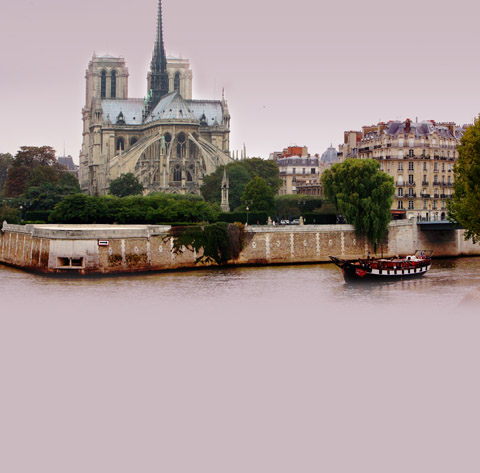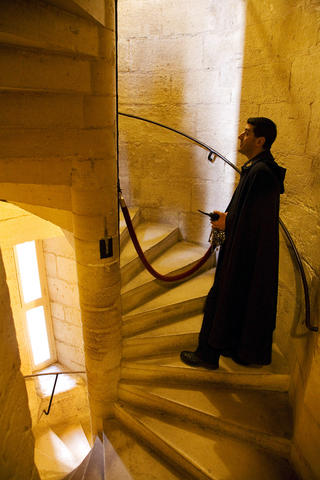Stephane Urbain stood leaning against a heavy wood frame high in the north tower of the Cathedral of Notre Dame, wrapped in a navy blue woolen cape against the wind, as he waited for the bells to sound.
Then three of the four immense bells tolled, shaking the massive oak frame, which weighs more than 187 tonnes.
“C-sharp, D-sharp twice, F,” Urbain said, a broad smile lighting up his face, even in the darkness of the bell cage.

PHOTOS: NY TIMES NEWS SERVICE AND AFP
Urbain, a 40-year-old chemist by training, is the chief sacristan of the cathedral. As such, he is also the chief bell ringer. His role often brings mention of Quasimodo, Victor Hugo’s character in The Hunchback of Notre Dame, who as the bell ringer was deafened by the volume.
Urbain rejects the comparison. “I am a little musical,” he said, with characteristic understatement, receiving a visitor amid the robes and golden liturgical vessels of the sacristy. His musicality has led to a minor revolution in the way that the bells have been rung since he became the chief sacristan three years ago.
This has put him in conflict at times with the caretakers of the bells. These specialists visit the towers six times a year to check the condition of the bronze, examine the electric motors with their intricate chains that now swing the bells and inspect the wooden frame from which they are suspended.

PHOTOS: NY TIMES NEWS SERVICE AND AFP
The caretakers want less music, to diminish wear on the centuries-old bells. Urbain wants more, to restore the art to what it must have been when the bells were young.
Victor Hugo and Walt Disney aside, ringing the bells may never have involved swinging from a rope. The bells — four smaller ones in the north tower of the cathedral and the bass bell, or bourdon, in the south — still display the remains of wooden platforms and metal bars that the bell ringers used to swing the huge bells by pumping with their feet. They were electrified in 1930, and are now controlled electronically by computer. Urbain is a master of software programming as well.
Still, there are occasional slip-ups. In 2004, during Holy Week, a mechanical failure silenced the bells for several days. “Cardinal Lustiger was furious,” said Urbain, referring to the late Jean-Marie Lustiger, who was then archbishop of Paris.
Urbain became keeper of the Notre Dame bells pretty much by accident. He was trained in chemistry but had a job when he was in school with the man who took care of the famed carillon at Lourdes, the shrine in the French Pyrenees, not far from where Urbain grew up. Unable to find work in his field, he came to Paris about 10 years ago and was able to use his experience to join the cathedral staff. In 2005, when the chief sacristan moved on to be chief guardian of the cathedral, Urbain succeeded him.
With a staff of four sacristans, he is responsible for the smooth organization of the liturgical services, from simple Masses by the cathedral clergy to elegant services involving the cardinal. But his real passion is the bells.
Notre Dame has 11 of them. The four in the north tower were cast in 1856 to replace older ones that were melted down during the French Revolution to make cannons and coins. The 14 tonne bass bell in the south tower was cast in 1680 and is supported by a vast wooden cage that dates to the Middle Ages. Six small bells were installed in the 19th century in and below the spire above the church’s transept. The bells, as sacred instruments, are all christened: the bass bell is Emmanuel; the largest of the smaller bells is Angelique Francoise; the smallest, Denise David.
Almost as soon as he took office, Urbain began to change the way the bells were rung, drawing on his experience at Lourdes. “There was no plan, the bell ringing was always the same,” he said.
The bells were mainly used to sound with simple strokes the thrice-daily Angelus and the Masses on Sunday. But Urbain realized that he could program the four north tower bells to ring bars of well-known music, including the Bach chorale Nun Komm, der Heiden Heiland, or at Easter time the hymn Regina Coeli Laetare. The bass bell posed more of a challenge. It was rarely rung except for solemn feasts like Easter or to mark the death of a pope or archbishop of Paris. But Urbain devised programs combining the bass bell and the four lesser bells.
Urbain acknowledges that his changes have caused problems. “The more you use them, the more the bells wear down,” he said. To reduce wear the clapper in the bass bell, which weighs more than 450kg, is now made of soft steel. The additional use also strains the electric motors that pull chains to set the bells ringing.
Nicolas Gueury could not agree more. Gueury is deputy director of Mamias, part of the Biard-Roy group that specializes in the care of bells, including these. During a recent inspection, he pointed to worn spots on the rim of the bass bell, where the clapper hits, and said that if the wear continued it could cause the bell to split, like the Liberty Bell in Philadelphia. “A bell is a note, like the string of a piano,” he said. The bass bell, in his view, is “the most beautiful of the bells.”
“By its weight, by its antiquity, and by its musical quality, it is the most pure,” he said.
The caretakers occasionally turn the bells so that the clapper hits a different area of the rim, reducing wear. His two experts clambered over the bells. Roger Lucot, 48, climbed on the clapper of one bell and rode it, Tarzan-like, until it struck the far rim. They greased the moving parts and tested the electric motors and the drive chains. One chain needed replacing.
“Here in Notre Dame we have a precautionary system,” Gueury said. “Before it breaks, we hope to catch it.” Urbain agrees the goal must be not only to use, but also to preserve the bells. “I have more ideas,” he said. “We will have fewer bells in Lent ... but we will have a full program, particularly at Easter time.”
Urbain loves the bells, he said, but as part of the whole cathedral. “And she is a very jealous and possessive woman,” he said.

Wooden houses wedged between concrete, crumbling brick facades with roofs gaping to the sky, and tiled art deco buildings down narrow alleyways: Taichung Central District’s (中區) aging architecture reveals both the allure and reality of the old downtown. From Indigenous settlement to capital under Qing Dynasty rule through to Japanese colonization, Taichung’s Central District holds a long and layered history. The bygone beauty of its streets once earned it the nickname “Little Kyoto.” Since the late eighties, however, the shifting of economic and government centers westward signaled a gradual decline in the area’s evolving fortunes. With the regeneration of the once

Even by the standards of Ukraine’s International Legion, which comprises volunteers from over 55 countries, Han has an unusual backstory. Born in Taichung, he grew up in Costa Rica — then one of Taiwan’s diplomatic allies — where a relative worked for the embassy. After attending an American international high school in San Jose, Costa Rica’s capital, Han — who prefers to use only his given name for OPSEC (operations security) reasons — moved to the US in his teens. He attended Penn State University before returning to Taiwan to work in the semiconductor industry in Kaohsiung, where he

On May 2, Chinese Nationalist Party (KMT) Chairman Eric Chu (朱立倫), at a meeting in support of Taipei city councilors at party headquarters, compared President William Lai (賴清德) to Hitler. Chu claimed that unlike any other democracy worldwide in history, no other leader was rooting out opposing parties like Lai and the Democratic Progressive Party (DPP). That his statements are wildly inaccurate was not the point. It was a rallying cry, not a history lesson. This was intentional to provoke the international diplomatic community into a response, which was promptly provided. Both the German and Israeli offices issued statements on Facebook

Perched on Thailand’s border with Myanmar, Arunothai is a dusty crossroads town, a nowheresville that could be the setting of some Southeast Asian spaghetti Western. Its main street is the final, dead-end section of the two-lane highway from Chiang Mai, Thailand’s second largest city 120kms south, and the heart of the kingdom’s mountainous north. At the town boundary, a Chinese-style arch capped with dragons also bears Thai script declaring fealty to Bangkok’s royal family: “Long live the King!” Further on, Chinese lanterns line the main street, and on the hillsides, courtyard homes sit among warrens of narrow, winding alleyways and